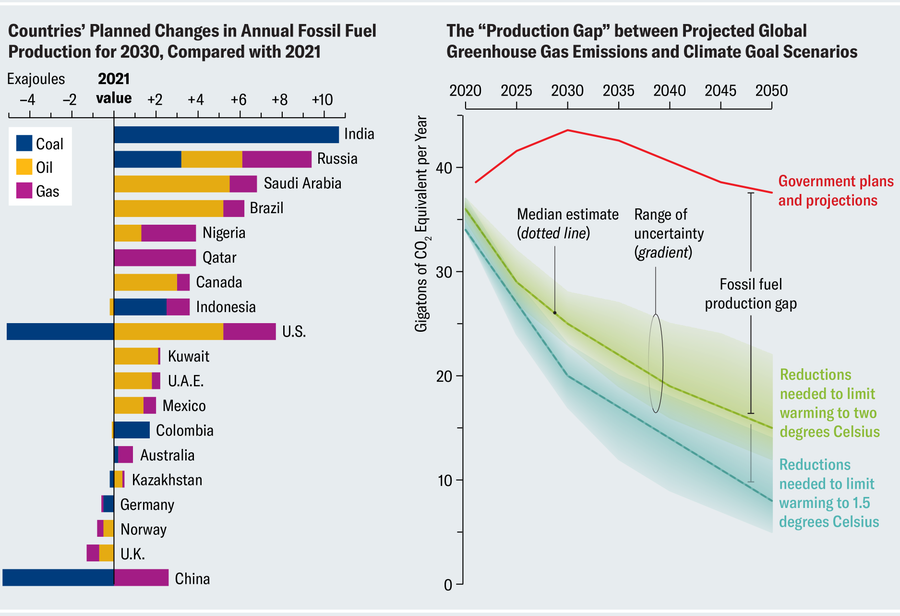January 4, 2024
5 min learn
As we careen on a local weather disaster, the COP28 convention has witnessed world leaders’ failure to avert clear catastrophe for humanity

The United Nations Local weather Change Convention ended final month, and its small successes may barely masks its failure to face a worsening climate catastrophe. COP28 highlights included greater than 120 nations pledging to triple their renewable power capability by 2030 and a number of other nations pledging a complete of $700 million to a loss and damage fund compensating susceptible communities after climate disasters. Almost 200 nations agreed to transition “away from fossil fuels in power programs in a simply, orderly and equitable method.”
Sadly, the assembly supplied neither a timeline nor assurance that the purpose of the 2015 Paris Settlement—limiting international warming to 1.5 or two levels Celsius—might be met. Extremely, a number of the nations calling for a phasedown of fossil fuels, together with the U.S., are literally planning to increase their manufacturing of oil and gasoline. A “transition,” to oil-producing nations, appears to imply staying in enterprise till demand drops. The tepid response to this looming disaster is a grave mistake; it’s time for daring, uncompromising motion.
Thus COP28 provides little hope for substantial deviation from present stagnant efforts to avert catastrophe. A lot of its obvious successes include worrisome caveats. Two of the largest local weather polluters, China and India, did not, for example, sign the pledge to triple their renewable power capability, probably due to its anti-coal language. Additional, some athletes earn more than their respective nations’ nationwide COP28 Loss and Harm Fund pledge. These pledges are a pittance that, in complete, account for only a fraction of a percent of the annual climate-related damages confronted by growing nations. Even worse, the settlement to transition away from fossil fuels lacks enamel: it sidesteps authorized obligations, omits clear timelines and funding targets and, shockingly, neglects to demand a phasing-out of fossil fuels that had been backed by greater than 100 nations.
“Life on planet Earth is below siege. We are actually in an uncharted territory,” we wrote in a 2023 state-of-the-climate report. We’re, due to this fact, deeply involved that some policymakers and world leaders have gone far off monitor on addressing local weather change. In the course of the convention, the COP28 president criticized the idea of a fossil gas phaseout. COP resolutions require total consensus, to allow them to simply be watered down by petrostates that revenue drastically from fossil fuels.
After a long time of inadequate motion, we are actually experiencing a local weather emergency. In 2023 alone, many climate-related disasters struck, together with unprecedented warmth waves, wildfires, storms and flooding. For instance, local weather change seemingly intensified Storm Daniel, which killed hundreds of individuals this previous September, primarily in Libya. Excessive warmth was a selected concern for migrant workers getting ready COP28 websites, with experiences of laborers working outdoors in doubtlessly deadly 42-degree-C (107-degree-Fahrenheit) temperatures. As local weather change worsens and we enterprise additional into uncharted territory, some scientists are warning that we’re on monitor for doubtlessly one billion climate-related deaths whereas others have raised considerations about much more disastrous outcomes.
Regardless of decades of promises made at conferences like COP28, shockingly little local weather mitigation has come from world leaders, in an abdication of accountability that can echo throughout centuries. Reasonably, fossil-fuel emissions have soared and are actually at near-record ranges. The fast progress of coal-related CO2 emissions is especially troubling as a result of coal accounts for roughly 40 percent of global CO2 emissions. Whole coal emissions are presently at near-record levels.
As proven within the graphic under, lots of the world’s main fossil-fuel-producing nations really plan to dramatically ramp up manufacturing by 2030, though there are some exceptions. Whole future international fossil-fuel emissions projections look equally grim. For instance, the U.S. plans to extend annual oil manufacturing by roughly 5.2 exajoules—the equivalent of roughly 900 million barrels of oil, albeit with a corresponding lower in coal manufacturing. The most important fossil gas manufacturing enhance is projected in India: roughly 10.7 exajoules in coal-related power (1.86 billion barrels of oil equal). These will increase are driving a widening fossil gas “manufacturing hole” between our present pathway and what’s wanted to restrict common international warming to 2 levels C.
Because the fossil gas manufacturing hole continues to soar and limiting warming to 1.5 levels C turns into more and more unrealistic, a large 2.8-degree-C warming is predicted by the tip of the century. Along with the failure to agree on a fossil fuel phaseout at COP28, this implies that some world leaders might not but have come to grips with the local weather disaster. We as an alternative face a troubling future steered into by local weather insurance policies unguided by science.
Our predicament is simply partly attributable to oil-rich nations and the super-rich benefiting drastically from the established order. Merely comprehending the size of local weather impacts—doubtlessly synchronized global crop failures, the destruction of low-lying island nations, intense geopolitical conflict and hundreds of millions of deaths this century—poses one other problem. Maybe the one silver lining within the rising incidence of climate-related disasters is that consciousness of those catastrophic dangers could also be rising.
Step one to coping with an issue is to grasp the issue itself. The widening fossil gas manufacturing hole and common lack of serious developments at COP28 (and most previous COPs) means that some leaders and policymakers might not but admire the severity of the local weather disaster, at the same time as a many countries have referred to as for a fossil gas phaseout. COPs focus the world’s consideration on the accelerating disaster of global heating. That is necessary but not sufficient. We want efficient options, together with forming coalitions of prepared nations, implementing carbon pricing, reducing fossil subsidies and investing closely in renewables to make fossil fuels out of date. Any real technique to deal with international warming should finally transcend phrases and voting—it ought to embody a radical execution plan with outlined targets, express measures and mechanisms to make sure accountability for outcomes, all whereas prioritizing fairness and social justice. This can require real management.
That is an opinion and evaluation article, and the views expressed by the creator or authors will not be essentially these of Scientific American.




